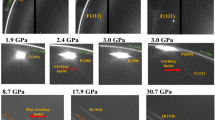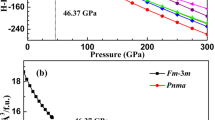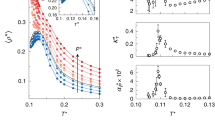Abstract
SPHERES can be stacked into two close-packed crystalline arrangements, face-centred cubic (f.c.c.) and hexagonal closed-packed (h.c.p.), which have identical close-packed volumes1 and very similar equations of state2. But they are structurally distinct, implying that they might have different thermodynamic properties and stabilities. Finding a difference in free energy between the two structures has been the objective of much theoretical3,4 and computational5–7 effort, but without a conclusive resolution. Here I report that a significant difference in the pressure–volume (P–V) behaviour can be detected in the vicinity of a mechanical instability point within a single-occupancy cell model8 of these packings. This model provides an exact thermodynamically reversible path between the two structures, and so the P–V isotherms can be integrated to obtain the Gibbs free-energy difference. I find that the f.c.c. phase is more stable by around 0.005RT per mol (where R is the universal gas constant); as the enthalpy difference is negligible, this implies that the entropy difference is of the order of 0.005R for all temperatures up to the melting point.
This is a preview of subscription content, access via your institution
Access options
Subscribe to this journal
Receive 51 print issues and online access
$199.00 per year
only $3.90 per issue
Buy this article
- Purchase on Springer Link
- Instant access to full article PDF
Prices may be subject to local taxes which are calculated during checkout
Similar content being viewed by others
References
Kittel, C. Introduction to Solid State Physics 5th Edn, Ch. 1 (Wiley, New York, 1976).
Alder, B. J., Hoover, W. G. & Young, D. A. J. Chem. Phys. 49, 3688–3696 (1968).
Stillinger, F. H. & Salsburg, Z. W. J. Chem. Phys. 46, 3962–3975 (1967).
Rudd, W. G., Salzburg, Z. W., Yu, A. P. & Stillinger, F. H. Jr J. Chem. Phys. 49, 4857–4863 (1968).
Alder, B. J., Carter, B. P. & Young, D. A. Phys. Rev. 183, 831–833 (1969).
Alder, B. J., Young, D. A., Mansigh, M. R. & Salzburg, Z. W. J. Comput. Phys. 7, 361–366 (1971).
Frenkel, D. & Ladd, A. J. C. J. Chem. Phys. 81, 3188–3193 (1984).
Kirkwood, J. G. J. Chem. Phys. 18, 380–382 (1950).
Hoover, W. G. & Ree, F. H. J. Chem. Phys. 49, 3609–3619 (1968).
Camahan, N. F. & Starling, K. E. J. Chem. Phys. 51, 635–638 (1979).
Woodcock, L. V. Ann. NY Acad. Sci. 371, 274–298 (1981).
Author information
Authors and Affiliations
Rights and permissions
About this article
Cite this article
Woodcock, L. Entropy difference between the face-centred cubic and hexagonal close-packed crystal structures. Nature 385, 141–143 (1997). https://doi.org/10.1038/385141a0
Received:
Accepted:
Issue Date:
DOI: https://doi.org/10.1038/385141a0
This article is cited by
-
Aggregate Engineering in Supramolecular Polymers via Extensive Non-covalent Networks
Chinese Journal of Polymer Science (2021)
-
Oncogenic G12D mutation alters local conformations and dynamics of K-Ras
Scientific Reports (2019)
-
A neutron tomography study: probing the spontaneous crystallization of randomly packed granular assemblies
Scientific Reports (2018)
-
Formation of self-assembled gold nanoparticle supercrystals with facet-dependent surface plasmonic coupling
Nature Communications (2018)
-
Polymorphism in a high-entropy alloy
Nature Communications (2017)
Comments
By submitting a comment you agree to abide by our Terms and Community Guidelines. If you find something abusive or that does not comply with our terms or guidelines please flag it as inappropriate.



